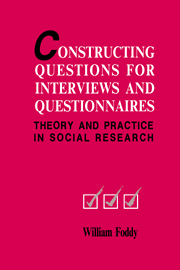Book contents
- Frontmatter
- Contents
- Tables
- Figures
- Preface
- Chapter 1 An initial statement of the problem
- Chapter 2 A theoretical framework
- Chapter 3 Defining topics properly
- Chapter 4 Formulating intelligible requests for information
- Chapter 5 Contextual influences on respondents' interpretations of questions
- Chapter 6 The need to provide response frameworks
- Chapter 7 The limitations of human memory
- Chapter 8 Filters: establishing the relevance of questions to respondents
- Chapter 9 Reducing question threat
- Chapter 10 The open vs. closed questions debate
- Chapter 11 Measuring attitudes
- Chapter 12 Checks to ensure that questions work as intended
- Chapter 13 Concluding comments
- The tap paradigm
- References
- Index
- Acknowledgements
Chapter 9 - Reducing question threat
Published online by Cambridge University Press: 04 September 2009
- Frontmatter
- Contents
- Tables
- Figures
- Preface
- Chapter 1 An initial statement of the problem
- Chapter 2 A theoretical framework
- Chapter 3 Defining topics properly
- Chapter 4 Formulating intelligible requests for information
- Chapter 5 Contextual influences on respondents' interpretations of questions
- Chapter 6 The need to provide response frameworks
- Chapter 7 The limitations of human memory
- Chapter 8 Filters: establishing the relevance of questions to respondents
- Chapter 9 Reducing question threat
- Chapter 10 The open vs. closed questions debate
- Chapter 11 Measuring attitudes
- Chapter 12 Checks to ensure that questions work as intended
- Chapter 13 Concluding comments
- The tap paradigm
- References
- Index
- Acknowledgements
Summary
Social researchers tend to take it for granted that respondents are, or can be, motivated to give them the information they require. In this chapter, however, we will look at the possibility that questions per se sometimes threaten respondents in a way that either influences their willingness to give answers at all or determines the nature of the answers that they do give.
It is well documented that material that is likely to be sensitive or embarrassing tends to be underreported in surveys. Locander et al. (1976), for example, showed that bankruptcy and arrest for drunken driving were reported at very low rates, despite the fact that they were unlikely to be forgotten. Cannell et al. (1965, 1977) showed that hospitalizations associated with diagnoses that were likely to be threatening or embarrassing were reported at lower rates than others. (Fowler and Mangione, 1990:78)
While it is generally recognised that respondents sometimes give biased answers and sometimes refuse to answer at all, it is nevertheless generally assumed that these problems can be overcome by one means or another.
In fact, a number of discussions of how to overcome the effects of question threat have been published over the years (e.g. Barton, 1958; Williams, 1964; Blair et al., 1977; Bradburn et al., 1978; Sudman and Bradburn, 1974, 1982; DeLamater, 1982). In Barton's words (1958:67), ‘the pollster's greatest ingenuity has been directed to asking embarrassing questions in nonembarrassing ways’.
- Type
- Chapter
- Information
- Constructing Questions for Interviews and QuestionnairesTheory and Practice in Social Research, pp. 112 - 125Publisher: Cambridge University PressPrint publication year: 1993



